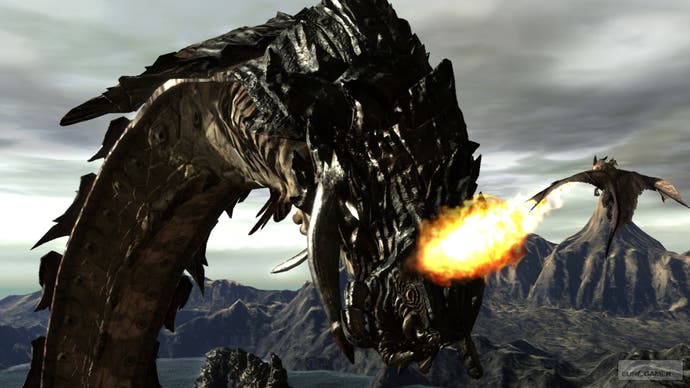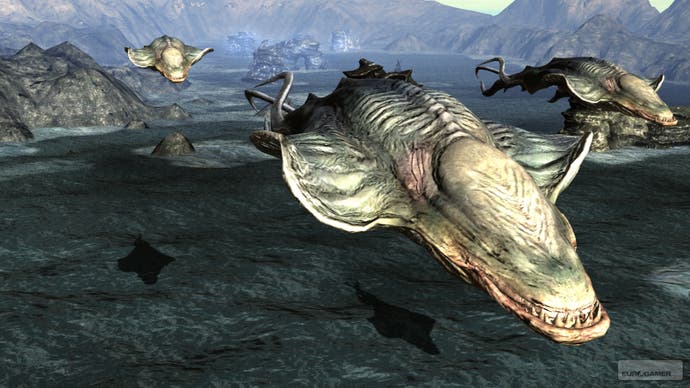Lair
Drags on. And on. And on.
Upon its American release, back in August, Sony's anticipated flappy dragon epic Lair received the sort of critical reception best described as a "drubbing". Much was said about the decision to use the Sixaxis motion sensor for control, with no option for traditional analogue stick control, and most of what was said was very bad indeed. Sony retaliated by sending out a "reviewers guide" to unimpressed journalists, explaining how to review the game, while Factor 5's Julian Eggebrecht rather patronisingly implored them to "open your mind and hands for something very different!"
Know this much: the slightly wonky control scheme is actually the least of Lair's problems.
It is, sadly, the sort of game that encapsulates all that is wrong with console transition periods, that development limbo where Next Gen and Last Gen overlap. It's a game full of ugly gameplay lurking behind pretty cutscenes, where visual showboating fails to mask gruesome design decisions. It's all mouth and no trousers, a clumsy and shallow experience that desperately tries to position itself at the start of a console's life as the Future Of Gaming. It is, ironically, much like Dragon's Lair - another slender gaming experience that relied on visual impact to distract from its hollow centre.

For all of Eggebrecht's evangelism, Lair is emphatically not "something very different". It's just another uninspired aerial combat game, in which the only innovation comes in the form of motion sensing control. If you've played Ace Combat, Panzer Dragoon or Crimson Skies then there's little here that you haven't seen before. Heck, it's almost identical in concept and intent to Thanatos, the sorely underrated ZX Spectrum game from Durell that did the giant flying dragon thing far better over twenty years ago: chewed-up enemies, sea serpents and all.
Lair's storyline follows Rohn, a dragon riding knight, the fighter pilot equivalent of his painfully generic fantasy world. There's a kingdom torn asunder by civil war, scheming politicians and reams of leaden purple prose that make the Star Wars prequels look like havens of naturalistic dialogue. The design and soundtrack, meanwhile, shamelessly strive for the sweeping majesty of Peter Jackson's Lord of the Rings trilogy without ever achieving the same level of emotional honesty or cultural verisimilitude. Unless you're the sort of person who eagerly buys pewter statues of trolls and dutifully reads books called The Moonsword of Gragarth: Volume XI of the Blood Riders of Ferax Saga, there's not a single element of the game's universe that will feel fresh or enticing. As your involvement in this lurid yarn is simply to fly around in between great gobs of exposition it's a real act of will to remain engaged with the lumbering plot.

Once you're in the air, and contrary to popular opinion, the basic controls are actually fairly intuitive. Banking left and right feels fluid and, while it admittedly takes a while to be able to navigate with accuracy, the spread of tutorials gives you plenty of opportunity to practice. Less successful are the 180 turn and forward thrust moves. To immediately reverse direction, an upwards jolt on the controller is required. Shoving the joypad forwards produces a burst of speed. At least, that's the theory. These moves actually highlight the shortcomings of the Sixaxis as a motion sensing device, often requiring several attempts before the game reads your movement and responds in kind. That it sometimes misreads one for the other can be hugely irritating, sending you barrelling onwards when you needed to go the other way.
Even so, it's not unworkable by any means, just a little fudgy and counter-intuitive. What it utterly fails to do, though, is justify the change in control. The game doesn't benefit in any appreciable way from the motion sensing, nor does it make the game more immersive. If anything, the opposite is true. The lightweight plastic of the Sixaxis doesn't sell the feeling of a monstrous beast at your command and jolting the controller up and down to perform simple functions simply serves to remind you that you're waggling a joypad to move a dragon on your telly. You're more focussed on what your hands are doing than what's on screen.

Still, the feeling you get as you swoop your leathery mount around the epic HD scenery is undeniably impressive first time out. Unfortunately, you're not in the game to go sightseeing and combat is where the game's real weakness lies. Battling airborne foes requires you to lock on to them, as a white halo appears around enemies in your sights (you have no on-screen reticule or any control over which enemy the game highlights) and R1 then fixes them in your baleful glare. A jab of the Square button sends a fireball their way (a homing fireball, apparently) while Circle sends your dragon hurtling towards them for some close-up scrapping. For weaker foes, this alone is enough to kill them and as they fall you can move the camera around to lock on to other nearby targets to rack up combo kills, pinballing through a flock of dragons.








